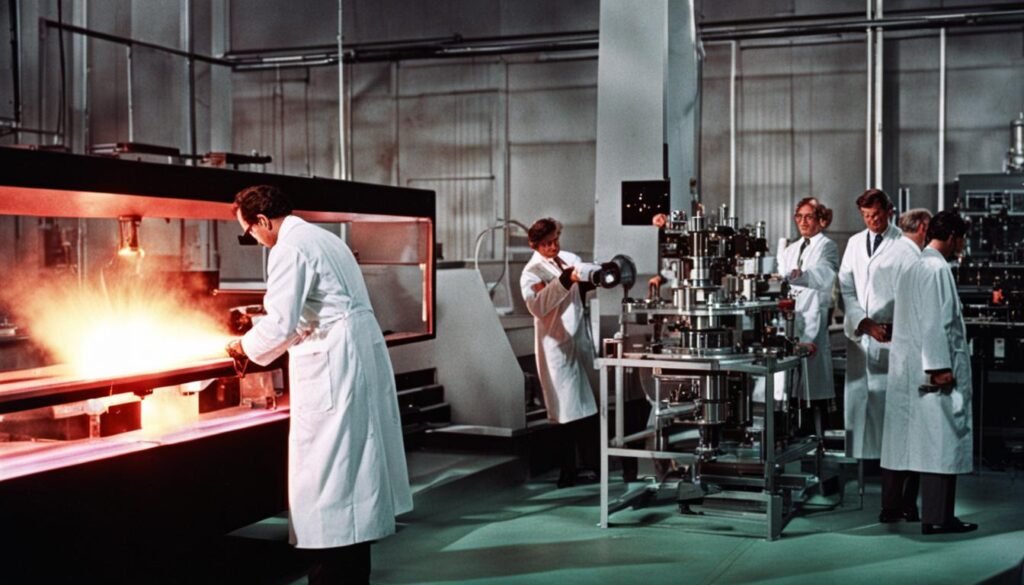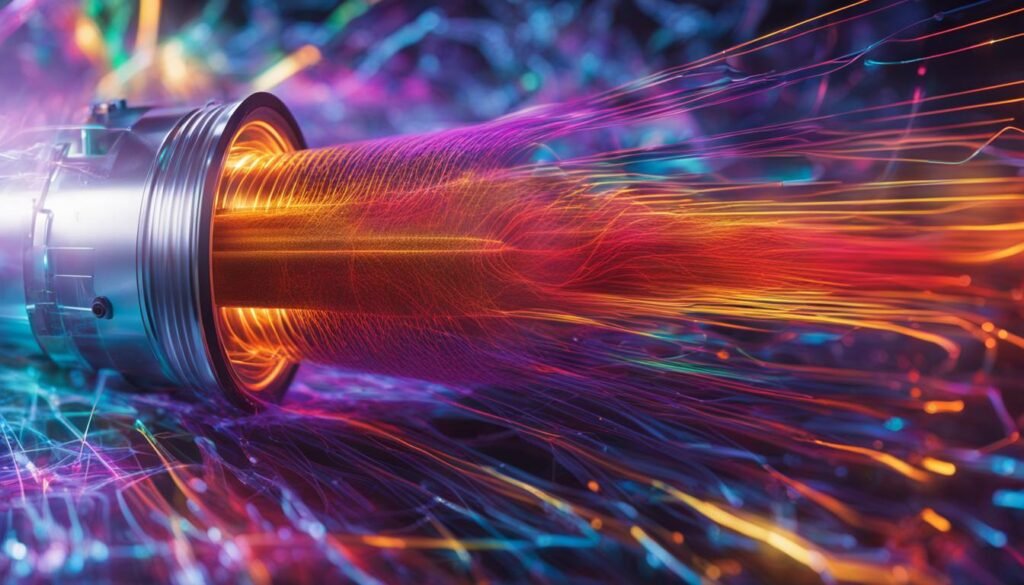Contents
Gas lasers are a pivotal component of laser technology, playing a crucial role in various laser systems and applications. Understanding the fundamentals of gas lasers is essential for grasping their significance in the field of laser engineering. This comprehensive guide aims to provide insights into the different types of gas lasers, their mechanisms, and the wide range of laser applications they enable.
Key Takeaways:
- Gas lasers are integral to laser technology and have diverse applications.
- The lasing medium in gas lasers consists of atoms or molecules in a gaseous state.
- Population inversion and optical feedback mechanisms are essential for laser emission.
- Gas lasers have a rich historical context, including the development of iconic lasers like the Helium-Neon laser and carbon dioxide laser.
- Various types of gas lasers exist, including Helium-Neon lasers, metal vapor lasers, noble gas lasers, and ion lasers.
Fundamentals of Gas Lasers
Gas lasers are a key component of laser technology, utilizing a unique lasing medium in the form of atoms or molecules in a gaseous state. The choice of gas or gas mixture plays a critical role in determining the properties of the laser, such as the emitted wavelength and operational efficiency. This section will delve into the fundamental aspects of gas lasers, including the concept of population inversion, the optical feedback mechanism for coherence, and the various excitation mechanisms employed.
One of the fundamental requirements for a gas laser to function is the achievement of population inversion. In this state, a majority of the particles in the lasing medium exist in an excited state rather than the ground state. This inversion of population densities allows for the amplification of light and the generation of a laser beam. The gas medium, whether it’s helium, neon, carbon dioxide, or other gases, plays a crucial role in facilitating this population inversion and determining the laser’s characteristics.
Gas lasers utilize an optical feedback mechanism to maintain coherence and generate a coherent beam of light. This mechanism involves two mirrors placed at the ends of the laser cavity, which create an optical resonator. The mirrors reflect the emitted photons back into the lasing medium, stimulating further emission and amplification. This feedback loop ensures the generation of a coherent and intense laser beam.
Excitation mechanisms play a vital role in energizing the gas medium and initiating the lasing process. Electric discharge, such as a high-voltage current passing through the gas, is one commonly used excitation method. This discharge provides the necessary energy to stimulate the atoms or molecules in the gas, resulting in the population inversion and subsequent laser emission. Other excitation methods include optical pumping, chemical reactions, and electron beam excitation, each suited for different types of gas lasers and applications.
Gas Lasers: A Closer Look
Gas lasers have a unique lasing medium composed of atoms or molecules in a gaseous state.
Gas lasers have evolved to become an essential tool in a wide range of applications, including telecommunications, medical diagnostics, and scientific research. By understanding the fundamentals of gas lasers, including the lasing medium, the concept of population inversion, the optical feedback mechanism, and the various excitation mechanisms, we can appreciate the significance of gas lasers in advancing laser technology and their impact on various industries.
Historical Context

Gas lasers have a rich history in the development of laser technology, playing a pivotal role in various industries. One of the earliest gas lasers to be developed was the Helium-Neon (HeNe) laser, which emerged in the 1960s. Known for its iconic red beam, the HeNe laser quickly became a popular choice for applications such as barcode scanners, laser pointers, and holography.
Following the HeNe laser, another significant advancement came with the development of carbon dioxide (CO₂) lasers. These lasers utilize a combination of carbon dioxide, nitrogen, and helium gases as the lasing medium. CO₂ lasers became widely used in medical treatments, industrial cutting, and welding due to their high power and efficiency.
In the late 20th century, Excimer lasers gained prominence for their unique properties. Excimer lasers are a type of gas laser that utilize rare gas and halogen molecules as the lasing medium. Known for their ability to generate ultraviolet light, Excimer lasers found applications in eye surgeries, semiconductor manufacturing, and scientific research.
While newer laser technologies such as laser diodes and solid-state lasers have emerged in recent years, gas lasers continue to be relevant and widely used across industries. Gas lasers offer distinct advantages in terms of their power, wavelength range, and precision. With ongoing research and innovation, the future of gas lasers holds promise for further advancements and expanding possibilities in various fields.
Significant Milestones in Gas Laser Development:
- 1961: Introduction of the Helium-Neon (HeNe) laser
- 1964: Development of the Carbon Dioxide (CO₂) laser
- 1970s: Rise of Excimer lasers and their applications in eye surgeries and semiconductor manufacturing
- 1980s: Advancements in Gas Laser technology, including shorter wavelength output and increased power
Key Applications of Gas Lasers:
- Telecommunications: Gas lasers are used in fiber optic communication systems for transmitting data over long distances.
- Medical: Gas lasers are utilized in various medical treatments, including laser eye surgeries, dermatological procedures, and cancer therapies.
- Manufacturing: Gas lasers play a crucial role in industrial processes such as material cutting, welding, and micromachining.
- Scientific Research: Gas lasers are indispensable tools in various research areas, including spectroscopy, atomic physics, and quantum optics.
In summary, the historical context of gas lasers highlights their significance and impact in laser technology. From the early emergence of the HeNe laser to the versatile applications of gas lasers in medical, manufacturing, and scientific fields, gas lasers continue to evolve and contribute to advancements in various industries.
Types of Gas Lasers

Gas lasers encompass a variety of types, each with unique characteristics and emission spectra. These lasers have diverse applications in different fields, ranging from scientific research to industrial processes. Let’s explore some of the most notable types:
Helium-Neon Lasers
Helium-Neon lasers are among the most common gas lasers used today. They operate by using a mixture of helium and neon gases as the lasing medium. These lasers emit a red beam and are widely used in applications such as laser pointers, barcode scanners, and holography.
Metal Vapor Lasers
Metal vapor lasers utilize metals such as copper or gold as the lasing medium. These lasers emit at specific wavelengths and find applications in dermatological treatments, where precise control of the laser’s energy and wavelength is crucial. Additionally, metal vapor lasers play a significant role in industrial processes like laser cutting and welding.
Noble Gas Lasers
In noble gas lasers, noble gases such as argon, krypton, and xenon serve as the lasing medium. These lasers are commonly used in spectroscopy and experimental physics, where their unique properties enable precise analysis and research.
Ion Lasers
Ion lasers utilize noble gas ions, such as argon or krypton, to produce high-output power and distinct colors. These lasers are employed in various applications, including biomedical research, spectroscopy, and entertainment, where their exceptional beam quality and versatility are highly valued.
| Laser Type | Application |
|---|---|
| Helium-Neon Lasers | Laser pointers, barcode scanners, holography |
| Metal Vapor Lasers | Dermatological treatments, laser cutting, welding |
| Noble Gas Lasers | Spectroscopy, experimental physics |
| Ion Lasers | Biomedical research, spectroscopy, entertainment |
Conclusion
Gas lasers have played a vital role in the laser industry, driving significant advancements in laser technology. Through extensive research, laser development, and manufacturing, gas lasers have proven their unique capabilities and versatility in various fields.
From industrial applications to medical treatments, gas lasers have made significant contributions across a wide range of industries. Their impact extends to scientific research, where they continue to enable breakthroughs in understanding and experimentation.
While newer laser technologies have emerged, the importance of gas lasers remains undeniable. With ongoing laser research and innovation, the future of gas lasers holds promising possibilities for further advancements and new applications. The laser industry will continue to leverage the power of gas lasers to push the boundaries of what is possible in the world of optics and laser technology.
FAQ
What is a gas laser?
A gas laser is a type of laser that uses atoms or molecules in a gaseous state as the lasing medium. The choice of gas determines the laser’s properties and operational efficiency.
How do gas lasers work?
Gas lasers utilize an optical feedback mechanism with two mirrors to generate a coherent beam. The lasing medium is energized through excitation mechanisms such as an electric discharge, and cooling and regeneration processes are employed to maintain optimal temperature and preserve the gas medium.
What are the different types of gas lasers?
Gas lasers come in various types, including Helium-Neon lasers, metal vapor lasers, noble gas lasers, and ion lasers. Each type has unique characteristics and emission spectra, making them suitable for different applications in industries such as medicine, industry, and scientific research.
What are the applications of gas lasers?
Gas lasers have a wide range of applications in fields such as telecommunications, medical diagnostics and treatments, industrial cutting, dermatological treatments, spectroscopy, entertainment, semiconductor manufacturing, and scientific research.
Why are gas lasers still important despite the emergence of newer laser technologies?
Gas lasers continue to play a significant role in various industries due to their unique capabilities and applications. Ongoing research and development drive advancements in gas laser technology, promising further advancements and expanding possibilities in the future.



